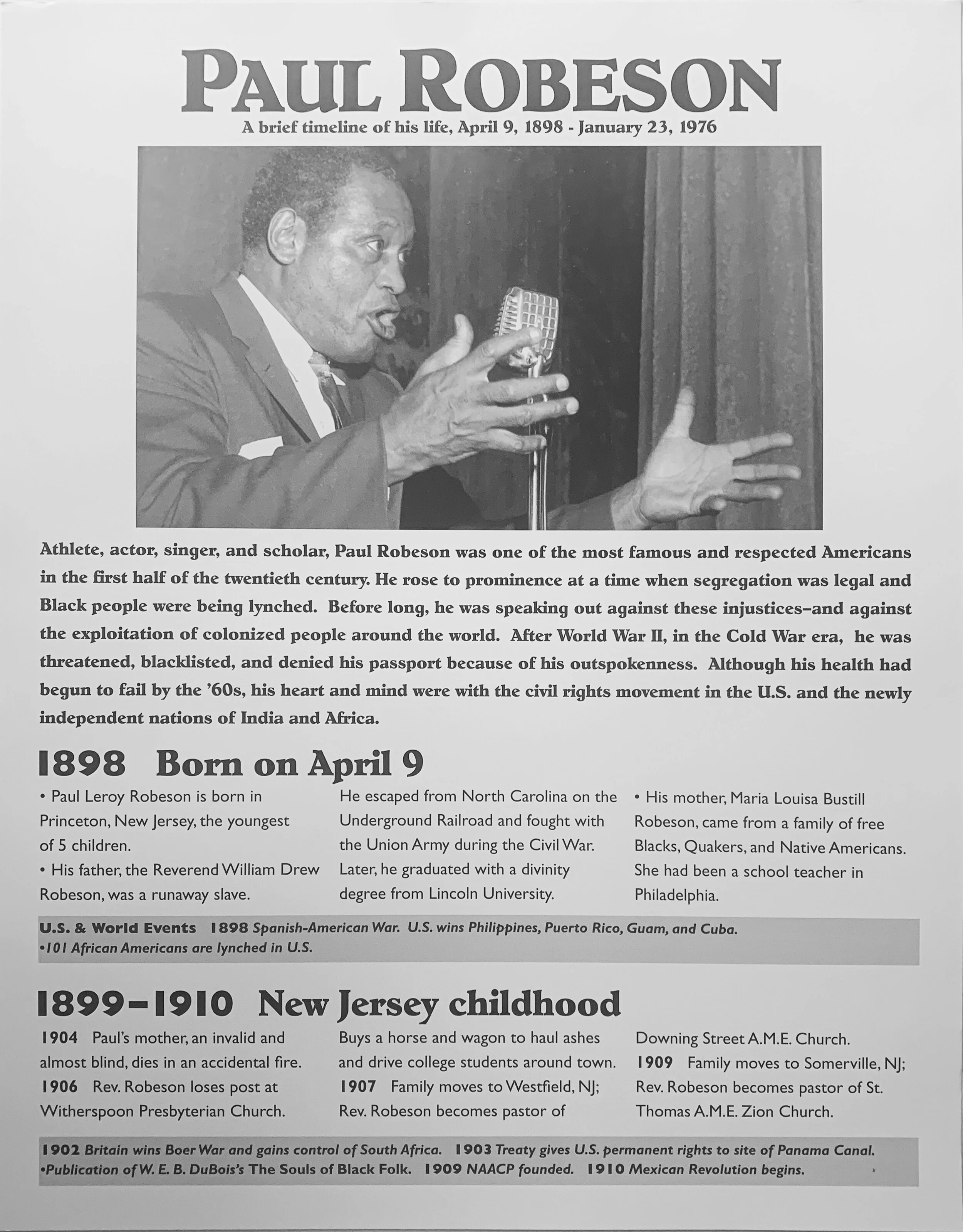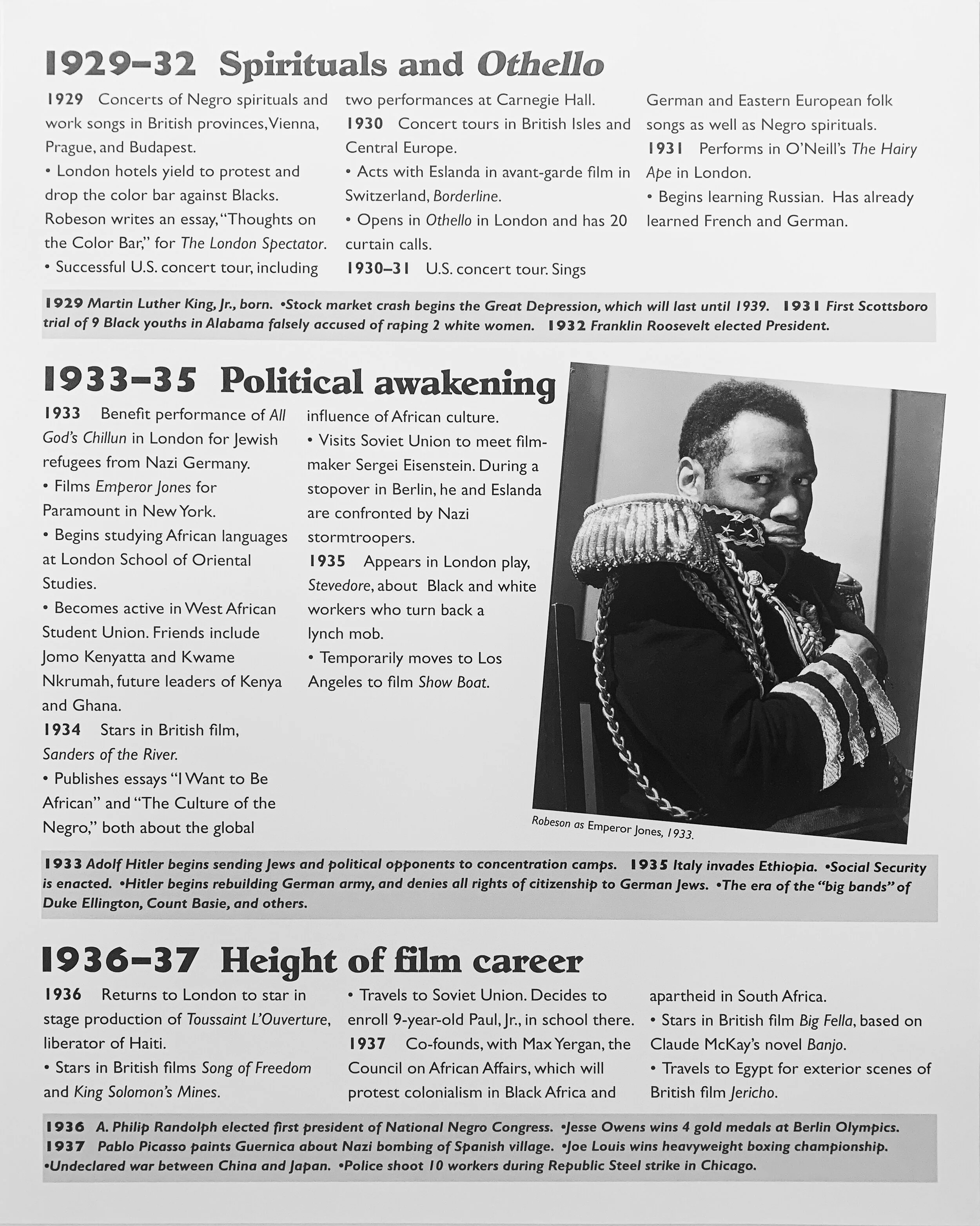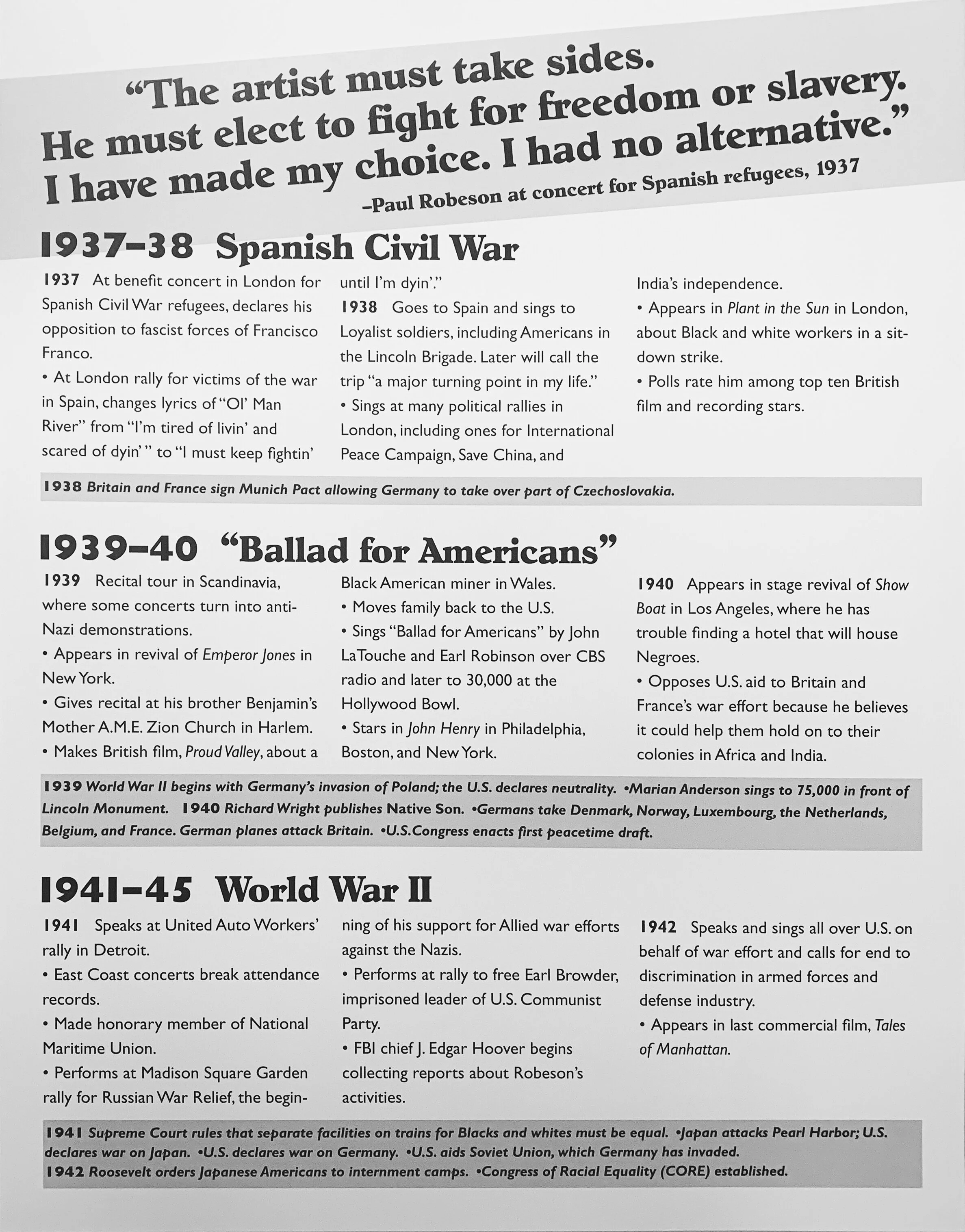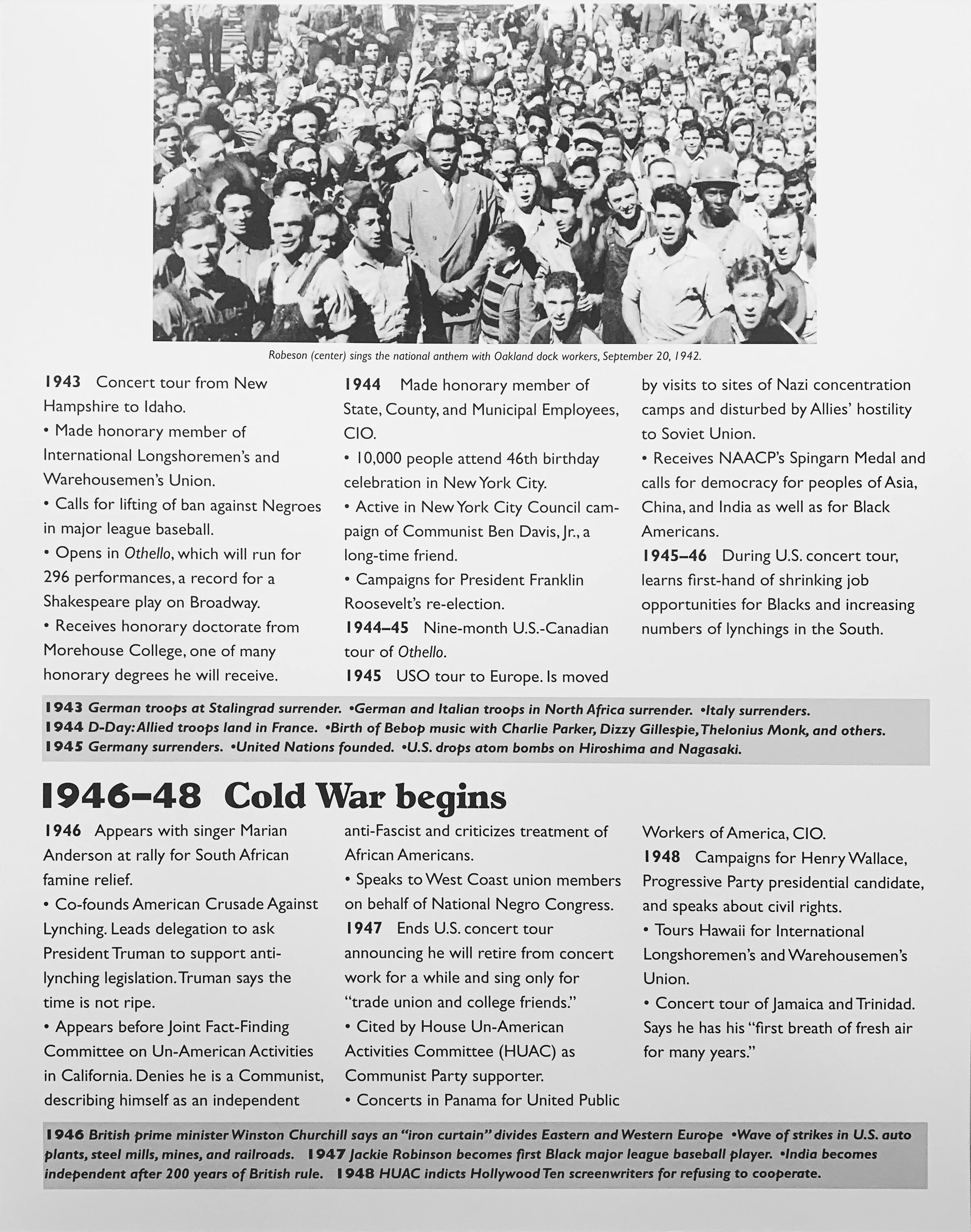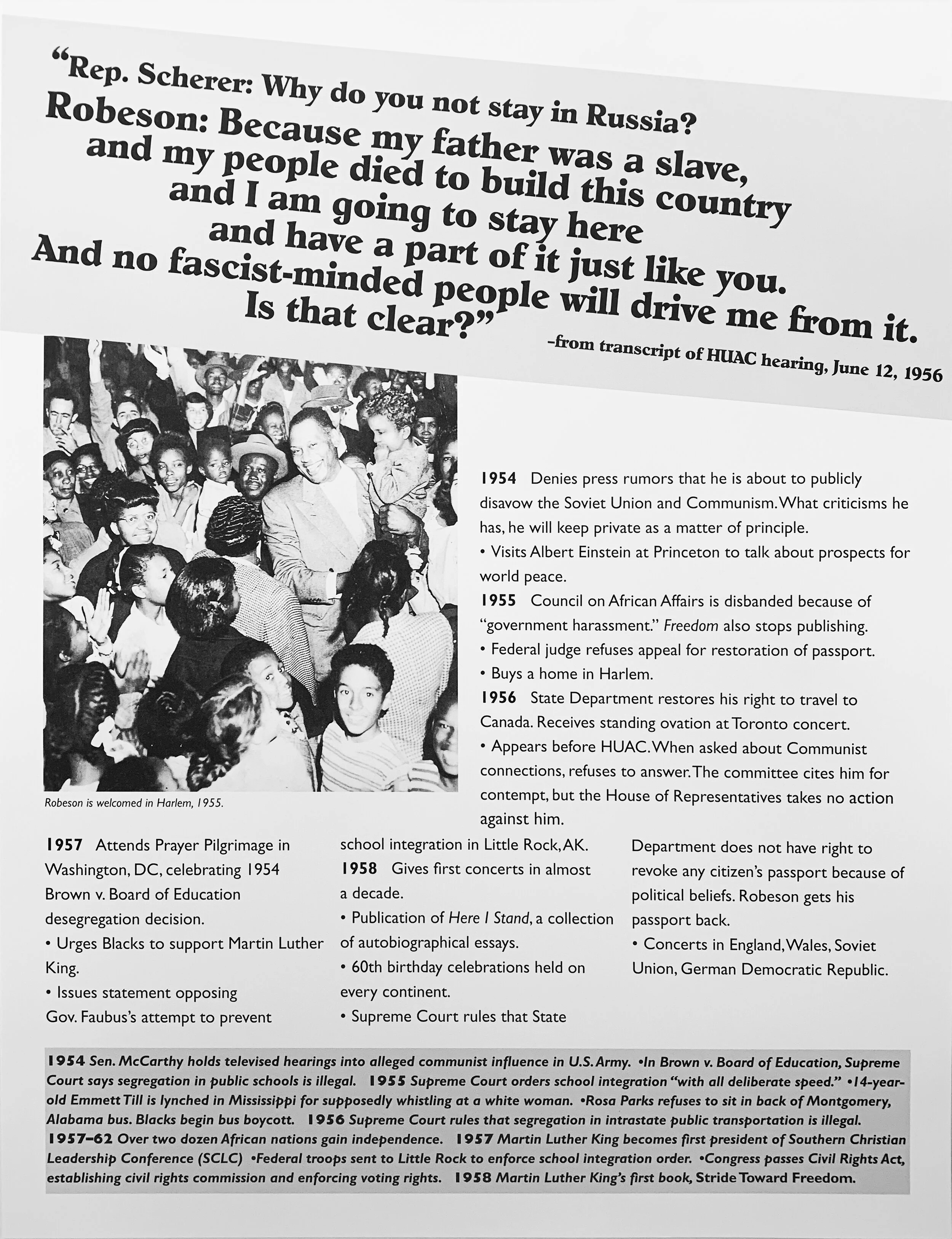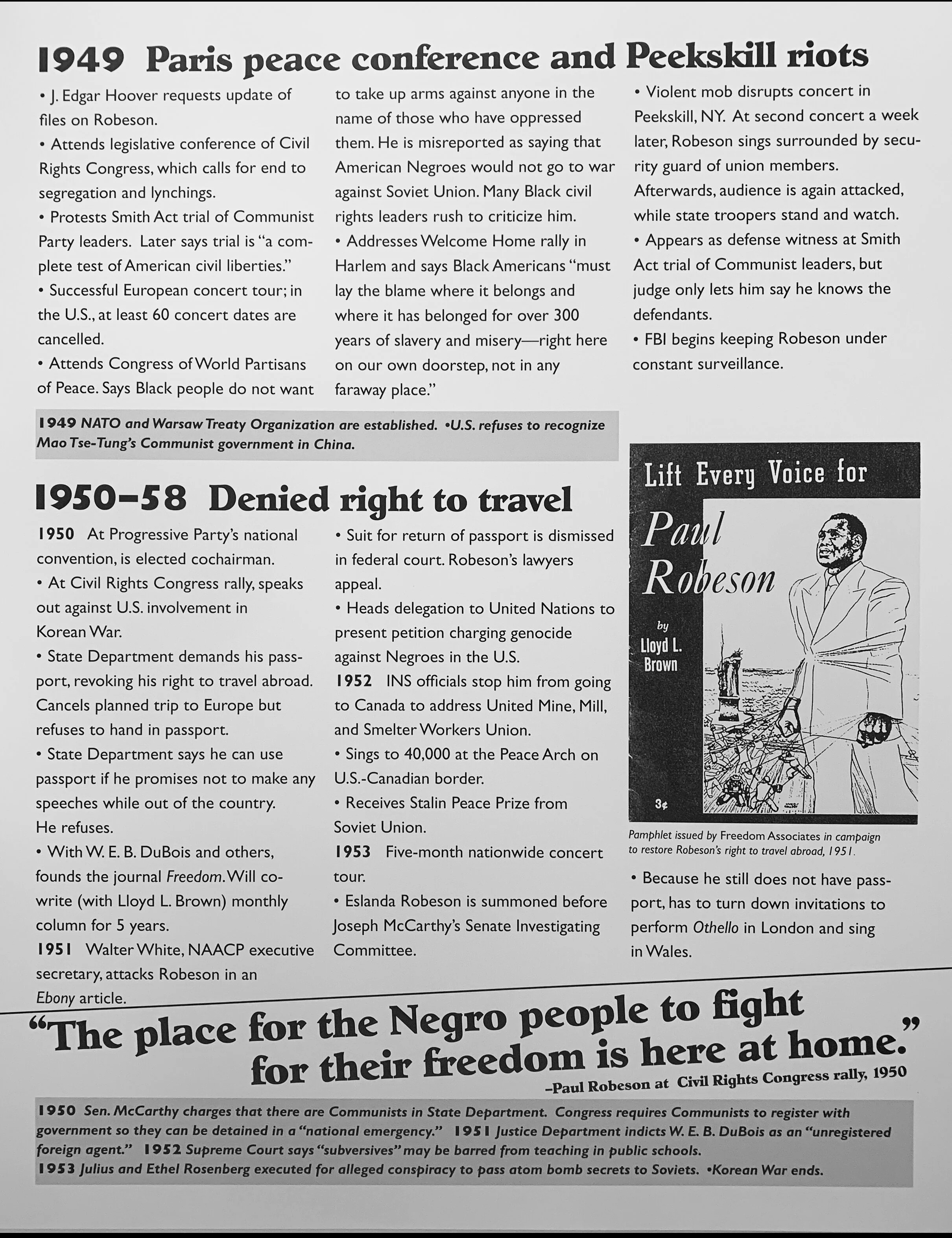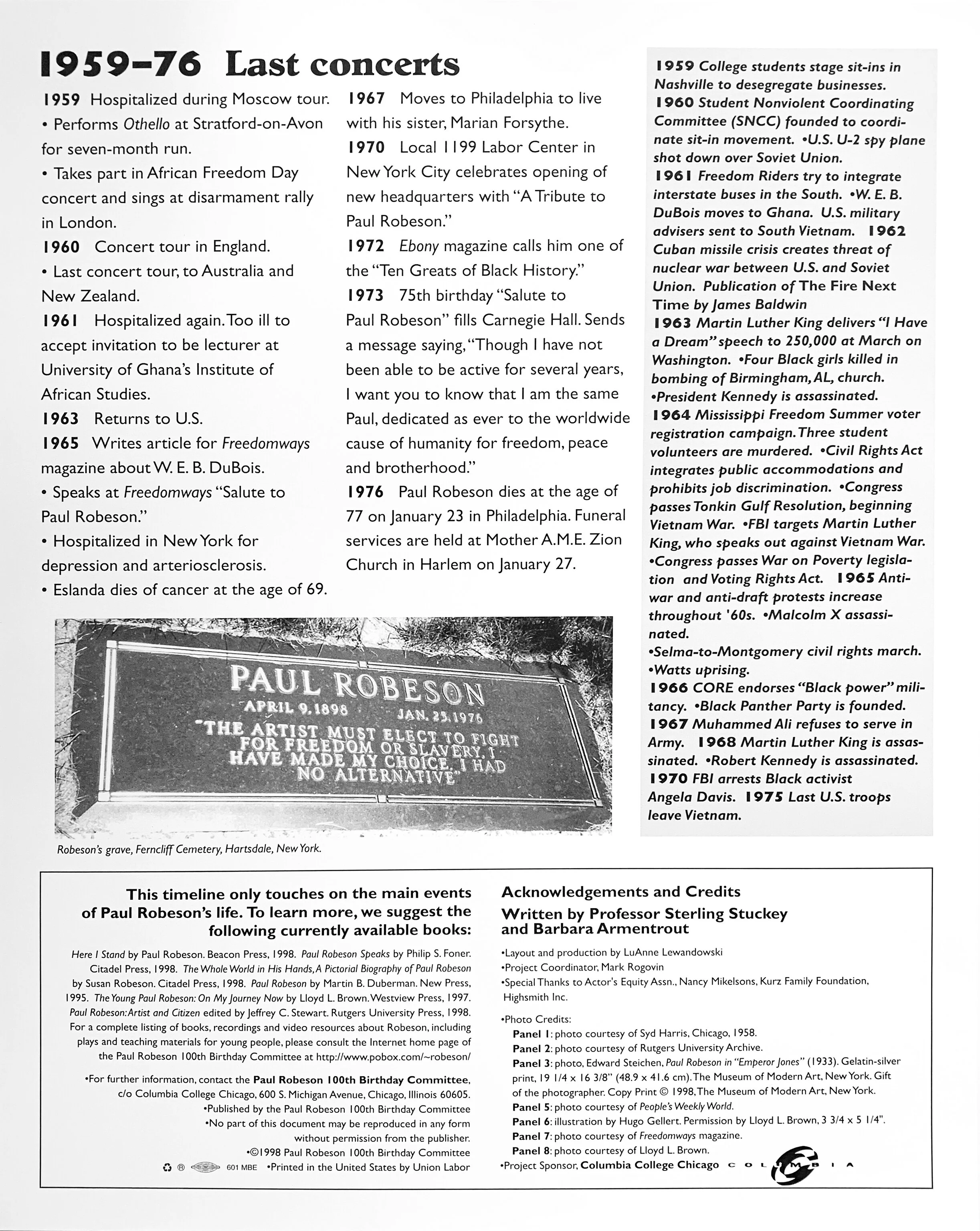Robeson Centennial Organization
In 1997 I was reading a book on Paul Robeson and noted that his centennial, the 100th year from the year of his birth (1898) was coming up. I thought that I should gather together some people to help create a major celebration of this powerful man.
Robeson was a hero in our family. We never saw him in person but had many of his record albums--and loved his voice and politics. As children, we sang and danced to his songs. The one time that our family was to see Paul in Buffalo, one of my sisters woke up the day of the event with measles or some other illness.
I approached many folks with the fact that the centennial was coming up in less than 2 years. Except for a few people, the rest said to bring them into the organizing maybe 6 months in advance of the centennial. I knew that in order for the celebration to be truly an immense event that a lot of time was needed to get the work done.
I contacted Margaret Burroughs, Nancy Mikelsons, Don Goldhamer, and others. Mirron Alexandroff, president of Columbia College had just retired and the Robeson committee was given his "office emeritus" to work out of. Mirron never once used the office. Besides desks and file cabinets, there was a serious copy machine!
I had the idea of creating a display on the life of Paul Robeson. This was to be an 8 panel illustrated timeline, 20 by 26 inches. and was meant to be mounted in classrooms, community centers, a church... It was beautifully printed on heavy card stock by Salsedo Press.
Soon after the timeline was completed, I spoke to former Northwestern University scholar, Sterling Stuckey and asked him if he could take the timeline and turn it into a booklet for classroom use. Sterling said that he was too busy and to see if I could find someone to create the bones of the document. I contacted my friend Barbara Armentrout--and she said YES. She did the bulk of the writing and Sterling made comments and suggestions. The booklet was heavily illustrated.
I approached Alan Schwartz, a talented and progressive guitarist. He is the director of the (National) History Fair, the national organization that works with high school students. They were awarded for excellent scholarships in projects of local importance. I asked Alan if we could encourage suggest that as one topic for students to develop that the history of Robeson in the Chicago area would be interesting. He asked me if I knew any of Robeson's history in Chicago.
I saw this as a challenge--to find out about Robeson's history in the Chicago area. Robeson is known for his concerts theater in New York, London and Moscow--but little if anything in Chicago. Joe Powers was one of the volunteers in the Robeson centennial organization and I asked if he would work with me on this hunt. We asked many folks if they had memories of a Robeson event. The last time Robeson was in Chicago was 1958 so that is understandable. Chicago historian Timuel Black was one of our "advisors" and he was one of a few who had a clear memory of an event. This now 88 year old remembered his elementary school taking a yellow school bus to the Auditorium Theater--he remembered wearing a blue sweater. The event was Othello! Another couple, Ken and Margaret Karlin..."We were on the steps of the Field Museum [about 3/8ths of a mile to the Band Shell]. The whole place was jammed with people. No wonder they said 165,000 people--they could be low by one third!"
We decided that we needed to launch into the Chicago Tribune archives at the Chicago Historical Society (now the Chicago History Museum). The Communist Party loaned us 10 years of bound and semi bound volumes of The Worker. With the Worker, we skimmed page by page, hunting for the name Robeson. Every 5 or so minutes I would look over at Joe and say "Joe, don't read the articles--we are looking just for Robeson articles." Joe's background was with the Christian Left and not the Communist Party so he saw many articles that he was not familiar with.
The 38-page booklet we created was, Paul Robeson Rediscovered: An Annotated Listing of His Chicago History From 1921 to 1958. In the end, we wrote about 150 Chicago events, some small fundraising house parties, and one amazing concert in 1940 at the Grant Park Band Shell with an audience of 165,000 in attendance. In retrospect, we wished it would have incorporated illustrations beyond the ones on the front and back covers.
The first time Robeson came to town was in 1921 when he played for the Akron Pros. Paul's routine while at Rutgers was to leave for games on Friday afternoons. He would board a train and head for cities from Buffalo to Milwaukee. When we bumped into this fact in the Tribune we immediately called Timuel Black--he didn't believe it! We sent him a xerox of the article.
With all the work we did, it was our determination to build and feed other groups to get involved in the centennial. Our group sent out booklets and displays.
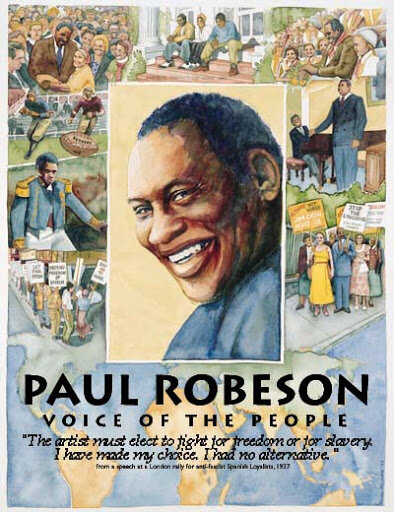
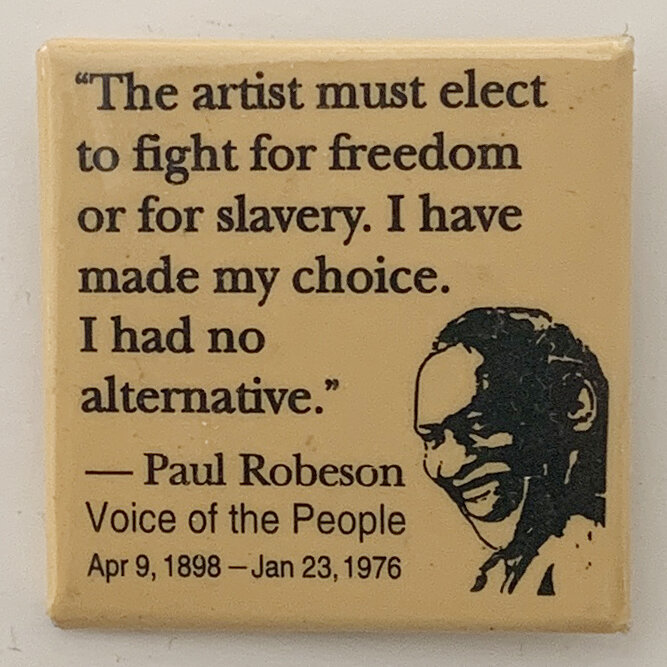

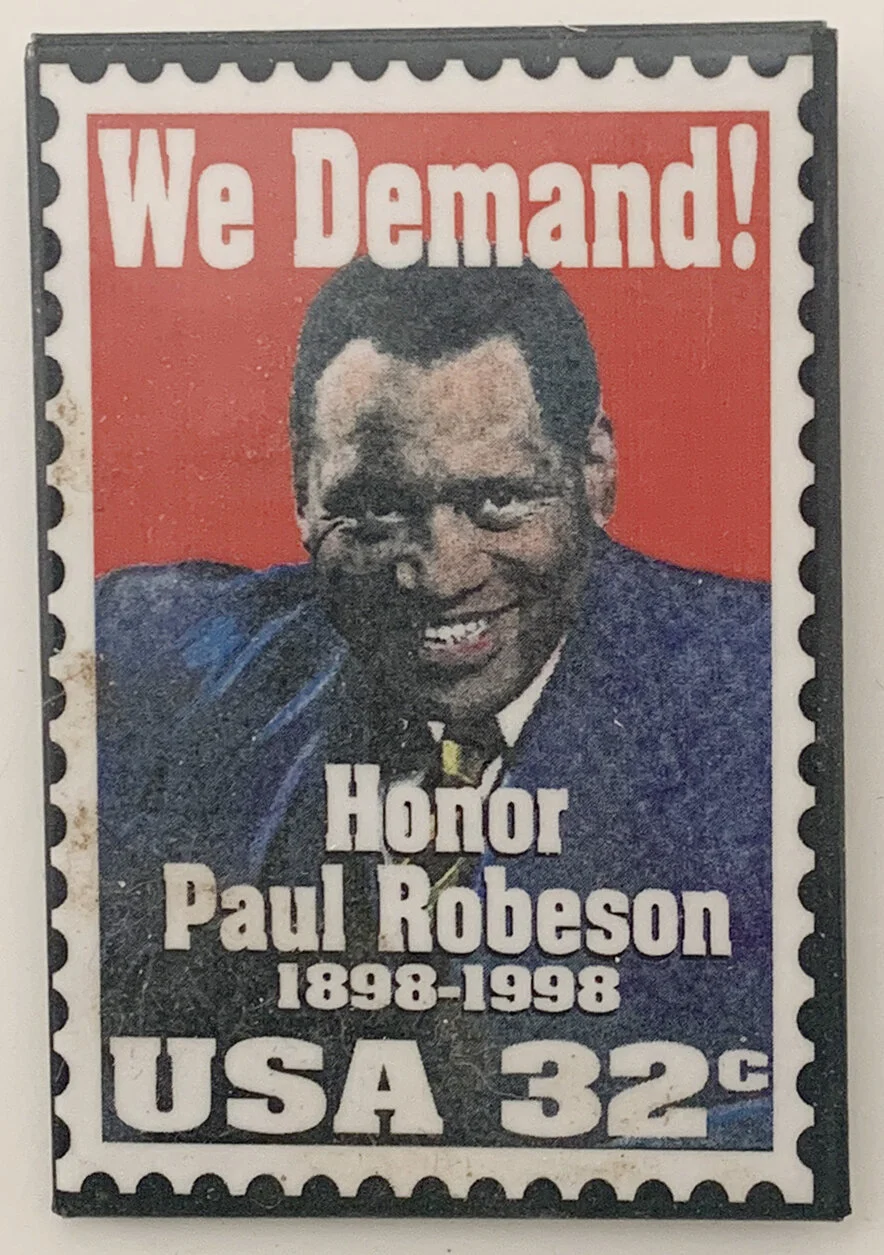
8 panel illustrated timeline
Album Releases
Mark helped locate several unpublished recordings of Paul Robeson’s recitals during this time, and with Folk Era Records, making them publicly available.
Paul Robeson in Chicago
We’re citizen historians or seat-of-the-pants historians. We came to this project with energy and stick-to-it-ism and certainly much love and respect for Paul Robeson. With the approaching 100th birthday of Paul Robeson (April 9, 1998), we realized that no one had a full sense of his involvement in the Chicago area—and we decided to begin this digging.
Our 4-year search began by speaking with some of our elders—some of the "old-timers" who went way back with Paul Robeson. We started by speaking with Dr. Margaret Burroughs and Ishmael Flory and Timuel Black. The list of Robeson events in Chicago started with six notations. Next, we used the book Paul Robeson by Martin B. Duberman, the 1970 thesis on Robeson by Anatol Schlosser, and Prof. Lenwood Davis’ book, A Paul Robeson Research Guide. We looked up references to Chicago and The Chicago Defender, the main African American newspaper in Chicago. Our list expanded to 35 events!
Next came numerous calls and visits—to the Chicago Historical Society, the Chicago Park District, the Harold Washington Library Center, and Orchestra Hall. Calls went out to dozens of institutions, high schools, and local newspapers to follow up leads.
In microfilm archives of The Chicago Defender, we found ads for upcoming concerts and articles which reviewed Robeson’s performances. These gave us confirmation of an event with its date and location and also could provide a fuller understanding of that event and of the times in which the event was held. For example, by reading a review of an Orchestra Hall concert on January 30, 1932, we discovered that this concert was a fundraiser. The event was in support of Helping Hand Community Day Nursery, a center for "both white and Colored children whose mothers are employed."
Linocut by Leopoldo Mendez
By looking at Chicago Defender articles adjacent to ones on Robeson, we could read articles by W.E.B. DuBois and Langston Hughes. We read, "Indict 13 in Illinois Lynchings," July 3, 1943, where the East St. Louis sheriff was one of those implicated. We gained a deeper sense of the times in which Robeson lived and the events that motivated his activism. In reading the Duberman book we learned that in 1934 Paul Robeson passed up "an offer from the Chicago Opera to do two performances of Amonasro in Aida (at a thousand dollars a performance . . .)."
Over and over again we bumped into really interesting material but it was not germane to our Robeson/Chicago research. We have a very full "Future Projects" file! We were so fortunate to have access to 8 years of the Midwest DuSable edition of The Worker newspaper. It was full of Robeson material and so difficult to quickly scan the brittle pages and not get sidetracked by reading "non-Robeson" articles!
Eslanda Robeson’s family had much history in the Chicago area. Her father graduated from Northwestern University and her mother set up a business on the South Side of Chicago. Eslanda was a student at Lucy Flowers High School and the University of Illinois/Chicago. It was the retired archivist Archie Motley at the Chicago Historical Society who showed us dozens of her original letters and articles written for Claude Barnett’s Associated Negro News Service. One day there will be a serious publication on Eslanda and her relationship with Paul Robeson. But our first task was to complete our Paul Robeson/Chicago research.
Eight months before completing this booklet, the FBI released 2,600 pages of its Robeson files on the Internet. A friend with a well-built printer downloaded it. It was a huge task to find material pertinent to our research. How ironic it was to use information collected by the FBI and police in the ’40s and ’50s to help piece together Paul’s history in Chicago! At Northwestern University we spent days looking through 9 reels of microfilm of a portion of the Robeson collection from the Schomburg Center for Research in Black Culture (N.Y. Public Library). It was packed with great material!
Rather than just a basic listing, we expanded certain descriptions when we had documentation that offered new insight into Paul Robeson. In a few instances, we listed events that were canceled. In each case tactics were used in an attempt to thwart the progressive viewpoint brought forward by Paul Robeson.
Our understanding of Robeson’s involvement in the Chicago area has become much richer. We found documentation about his pioneer performance of Negro Spirituals during his first concert at Orchestra Hall in 1926 and about his starring in Othello at the Erlanger Theater. We found a Chicago Tribune review of a concert where "Paul Robeson Wins Ovations From Throngs in Grant Park," on July 29, 1940, attended by 165,000 people! He and Joe Louis were cheered at the jam-packed American Negro Music Festival at White Sox Park in 1949.
During undergraduate school at Rutgers, Paul Robeson was the All-American football player. In order to pay for graduate school, he played professional football on weekends in cities including Buffalo, Syracuse, Akron, Detroit, Milwaukee, and Chicago. With the invaluable aid of volunteers, we uncovered three football games in Chicago that starred a six-foot-three-inch, 230-pound Paul Robeson. One of those games was an All-Star game at the once-famous Schorlings Park at 39th and Wentworth Avenue. The other games were in 1921 at Normal Park, now the site of Paul Robeson High School.
When Paul Robeson came to town he would piggyback many events around a scheduled commercial engagement. In a few days, he might have been involved in eight or more events. So, while our listing has over 140 events, we estimate that we are missing 100 or more concerts or rallies. We learned that except for commercial events, Paul Robeson would volunteer his services. Most often these events were for causes that he sincerely believed in and supported.
In the Spring of 1996, the Chicago-based Paul Robeson 100th Birthday Committee found a welcome home at Columbia College Chicago and together accepted a most challenging mission. That mission began by alerting key individuals and organizations worldwide of the upcoming centennial of Paul Robeson. Next, we identified already available resources such as books, plays, video, and audio material. If new or updated resources were needed, we helped get them produced. Our Internet website listed extensive resources for the study and celebration of Paul Robeson. A nationwide campaign for a Paul Robeson postage stamp was launched. We published the 24-page booklet, Paul Robeson’s Living Legacy by Barbara Armentrout and Prof. Sterling Stuckey. We wanted to bring back to life the concerns and campaigns and voice and energy of Paul Robeson.
Most young people have little or no knowledge of Paul Robeson. Certainly weaving the study of Robeson into school curricula was our ultimate goal. Hopefully, students will find special interest in the fact that Robeson’s journey took him around the world and in and out of Chicago. How exciting it would be for students to see Paul Robeson as a role model.
All back-up documentation on this Robeson/Chicago history booklet will be placed in the archive of Columbia College Chicago’s Center for Black Music Research (CBMR) and the Moorland Spingarn Research Center at Howard University in Washington D.C. All files and collecting by the Robeson Committee will be added to CBMR’s Robeson collection. The public will have access to photos, press, playbills, books, unpublished theses, and dozens of 78’s, LP’s, and CD’s. One gem in the collection is the 1943 Columbia Masterworks recording of Othello—the 3-volume set of seventeen 78’s!
We invite students, scholars, and other seat-of-the-pants historians to fill in the gaps. Help uncover additional events and old news articles, photos, playbills, speeches—maybe old recordings and film footage of our beloved Paul Robeson.
What we have compiled about Robeson’s Chicago history is something that needs to be pursued in numerous cities around the world. These diggings probably won’t make it into future books on Paul Robeson, but will help fill in the knowledge of the giant contributions Paul Robeson made for a just and peaceful world!
We encourage you to share this publication with friends and family—many of whom will have fond memories of Paul Robeson—and might have that Othello playbill still tucked away!
Joe Powers, Sr. - Retired government worker and activist
Mark Rogovin - Artist, founder of The Peace Museum, and project coordinator of the Paul Robeson 100th Birthday Committee



